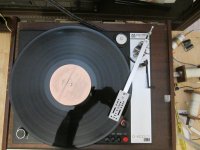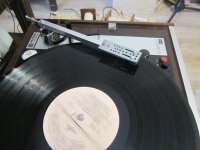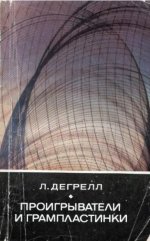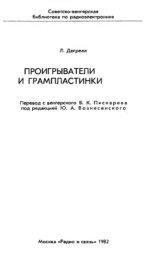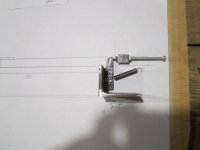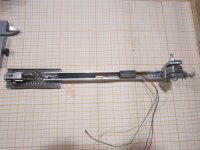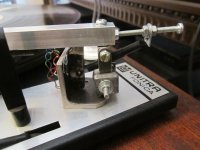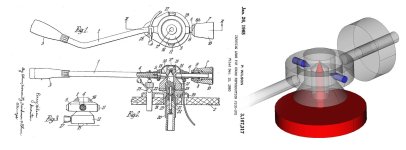Hi Niffy.
Thank you for your reply. I also admire your work.
Let me first digress from the topic. To my great regret, I have to communicate with you through an automatic translator. The translators on my phone and laptop often give completely different translations,you can see for yourself by looking at the screenshots and doing the reverse translation. Pay attention to your nickname. Which one is correct? That's why I will write in short, concise phrases and, sorry, you will not be able toenjoy the beauty of the Russian language. However, this will not give the automatic translatormany chances to greatly distort the meaning of what is written.
A few words about myself.
I am a pensioner, I am 67 years old, I live in Krasnodar. I listened to vinyl most of my life, then CDs, after retiring I got into vinyl again. I am a DIYer and I like to remake record players in my own way. A year and a half ago I got interested in tonearms, then I accidentally came across this forum. I read this thread and the thread "Angling for 90° - tangential pivot tonearms". At this stage I am working on tangential pivot tonearms of my own design, and I am also closely following this thread. I am a meticulous person when it comes to technical details, so please do not take my questions as criticism, they are of both purely academic and practical interest to me. In several of my posts I will explain why I came to this topic and not to the thread"Angling for 90° - tangential pivot tonearms" and ask questions that I did not find an answer to in the thread, or maybe I missed them by accident.
AG.
Thank you for your reply. I also admire your work.
Let me first digress from the topic. To my great regret, I have to communicate with you through an automatic translator. The translators on my phone and laptop often give completely different translations,you can see for yourself by looking at the screenshots and doing the reverse translation. Pay attention to your nickname. Which one is correct? That's why I will write in short, concise phrases and, sorry, you will not be able toenjoy the beauty of the Russian language. However, this will not give the automatic translatormany chances to greatly distort the meaning of what is written.
A few words about myself.
I am a pensioner, I am 67 years old, I live in Krasnodar. I listened to vinyl most of my life, then CDs, after retiring I got into vinyl again. I am a DIYer and I like to remake record players in my own way. A year and a half ago I got interested in tonearms, then I accidentally came across this forum. I read this thread and the thread "Angling for 90° - tangential pivot tonearms". At this stage I am working on tangential pivot tonearms of my own design, and I am also closely following this thread. I am a meticulous person when it comes to technical details, so please do not take my questions as criticism, they are of both purely academic and practical interest to me. In several of my posts I will explain why I came to this topic and not to the thread"Angling for 90° - tangential pivot tonearms" and ask questions that I did not find an answer to in the thread, or maybe I missed them by accident.
AG.
Attachments
Hi Andrey,
This thread and the angling for 90° thread have both become very long. Finding the information that you are looking for can be difficult. Especially if you are using a translation program. There is a lot of excellent information buried in them. If you can't find what you are looking for or need something explained please ask. We all like an engineering challenge and love to share the knowledge we have gained.
This thread and the angling for 90° thread have both become very long. Finding the information that you are looking for can be difficult. Especially if you are using a translation program. There is a lot of excellent information buried in them. If you can't find what you are looking for or need something explained please ask. We all like an engineering challenge and love to share the knowledge we have gained.
Hello Niffy and all forum participants.
I will continue.I will have to say a few words about the path that led me to this topic. At the beginning of my path as a tonearm builder, I conceived of building two ordinary tonearms of my own design, a simple and a complex one. However, after building a model of a simple tonearm (in the photo) and listening to it, I abandoned the further idea. Why? It was a short straight tonearm with the stylus not reaching the spindle. This is an amazing tonearm, it completely turned my understanding of the mechanism of extracting truly full-fledged sound from the groove of a vinyl record upside down.If earlier I was engaged in improving the anti-skating mechanism, I made designs with an ideal characteristic and believed that it worked perfectly, then after listening to many records with this tonearm, I realized that it is impossible to create an anti-skating that would automatically change the anti-skating force for all records. As a result, with a single adjustment of the anti-skating, on different records, sometimes on one side of the track, sometimes on the other, there is an undercount of musical information. This manifests itself in a lack of high-frequency sounds in one of the channels.
In the short straight tonearm I built, there is one point with zero error, and at this point the skating force is zero. And at this point and near it, I heard how music should sound with a full signal reading from both sides of the groove at the same time. This really struck me. I listened to many records in the area of the zero point and immediately compared them on a regular tonearm. And it turned out that on a significant number of records I listened to, there was clearly not enough high-frequency sounds in one channel or another, and on some it was the same.
This new understanding of the detrimental effect of the rolling force on the completeness of readingof sound information from both sides of the grooves made me turn my attentionto tangential tonearms.
I thank all my colleagues who read my introduction to the end.
In the next message I will tell you about the question that worries me and to whichI have not found an answer.
AG.
I will continue.I will have to say a few words about the path that led me to this topic. At the beginning of my path as a tonearm builder, I conceived of building two ordinary tonearms of my own design, a simple and a complex one. However, after building a model of a simple tonearm (in the photo) and listening to it, I abandoned the further idea. Why? It was a short straight tonearm with the stylus not reaching the spindle. This is an amazing tonearm, it completely turned my understanding of the mechanism of extracting truly full-fledged sound from the groove of a vinyl record upside down.If earlier I was engaged in improving the anti-skating mechanism, I made designs with an ideal characteristic and believed that it worked perfectly, then after listening to many records with this tonearm, I realized that it is impossible to create an anti-skating that would automatically change the anti-skating force for all records. As a result, with a single adjustment of the anti-skating, on different records, sometimes on one side of the track, sometimes on the other, there is an undercount of musical information. This manifests itself in a lack of high-frequency sounds in one of the channels.
In the short straight tonearm I built, there is one point with zero error, and at this point the skating force is zero. And at this point and near it, I heard how music should sound with a full signal reading from both sides of the groove at the same time. This really struck me. I listened to many records in the area of the zero point and immediately compared them on a regular tonearm. And it turned out that on a significant number of records I listened to, there was clearly not enough high-frequency sounds in one channel or another, and on some it was the same.
This new understanding of the detrimental effect of the rolling force on the completeness of readingof sound information from both sides of the grooves made me turn my attentionto tangential tonearms.
I thank all my colleagues who read my introduction to the end.
In the next message I will tell you about the question that worries me and to whichI have not found an answer.
AG.
Attachments
Hello Andrey,
Welcome to the exciting world of tonearms. This thread is about linear tracking tonearms, where the arm is tangentional to the groove at each point of stylus travel, and the pivot follows the stylus movement.
The other thread is about pivoted tangentional tonearms, where the arm is similar to the conventional pivoted arms, completed with a clever trasmission that makes the arm tangentional to the groove at each point of stylus travel.
It is difficult (for me) to decide from your photos, which category your arm belongs to.
Welcome to the exciting world of tonearms. This thread is about linear tracking tonearms, where the arm is tangentional to the groove at each point of stylus travel, and the pivot follows the stylus movement.
The other thread is about pivoted tangentional tonearms, where the arm is similar to the conventional pivoted arms, completed with a clever trasmission that makes the arm tangentional to the groove at each point of stylus travel.
It is difficult (for me) to decide from your photos, which category your arm belongs to.
Hello Icsaszar,
I think Andrey's tone arm is a straight tone arm with so-called underhang.
Ralf
I think Andrey's tone arm is a straight tone arm with so-called underhang.
Ralf
Hello lcsaszar and alighiszem.
I am a child of the USSR. And if you are about the same age as me, then you and I arechildren of the same camp, which was called socialist. I studied in the secondhalf of the 70s at the Leningrad Polytechnic Institute in the electromechanical faculty, where many students from different countries, including Hungary, also studied. But I personally did not know them,although I knew many foreigners.
I have been in the world of vinyl for a long time. In my younger years, the window into this amazing world was the book by yourcompatriot Laszlo Degrelle "Turn-tables and records" from 1982. By the way, it is still popular among theyounger generation.
I am glad that we are on the same wavelength and will be very happy to communicate with you in the future. And now let me ask the experts of tangential tonearms a question that interests me very muchand a good answer to it does not come to my mind.
AG.
I am a child of the USSR. And if you are about the same age as me, then you and I arechildren of the same camp, which was called socialist. I studied in the secondhalf of the 70s at the Leningrad Polytechnic Institute in the electromechanical faculty, where many students from different countries, including Hungary, also studied. But I personally did not know them,although I knew many foreigners.
I have been in the world of vinyl for a long time. In my younger years, the window into this amazing world was the book by yourcompatriot Laszlo Degrelle "Turn-tables and records" from 1982. By the way, it is still popular among theyounger generation.
I am glad that we are on the same wavelength and will be very happy to communicate with you in the future. And now let me ask the experts of tangential tonearms a question that interests me very muchand a good answer to it does not come to my mind.
AG.
Attachments
We all like an engineering challenge and love to share the knowledge we have gained.
Excellent answer, Niffy.
I am exactly the person who fits your DIY company perfectly. I also love solving technical puzzles. I set them for myself, and I solve them myself - very convenient.But I have a problem with my thought. No matter how much I try to make it do at least something, it does not want to work. I have to get up from the couch with a creak and go to the workshop to saw and solder. That's my lazy thought.And how did you solve this problem, how did you make your thought work? Or do you also have to saw yourself? Joke.
And now I'll move on to my question.
It was not without reason that in my introductory monologue I showed you my short straight tonearm and told you how it turned my mindupside down about the insidious rolling force. It was this tonearm that made me ask myself: Is it possible to create a mechanism that will make the needle always be at the point of zero skating force? After all, only at this point does the needle press with the same force on both sides of the groove, thereby ensuringfull reception of musical information from both sides of the groove. Therefore, I considered two options for tangential tonearms - linear and rotary. I am currently working on rotary tangential tonearms and the situation with them is more or less clear to me. But with linear ones, my studies are ahead and I cannot solve one problem. That is why I came here.
It is not for me to teach you that in a linear tonearm (I do not take into account motorized designs) the needle is driven to the centerby the outer side of the groove. As a result, the inner side is underloaded and some of the high-frequencyinformation is lost. This would not be so bad (given the low friction in your tonearm) on a record with a smalleccentricity of the central hole and this disadvantage could be overlooked. But unfortunately, mostrecords have a more significant eccentricity, noticeable to the eye. Thus, whether we want it or not, the groovedrives the needle with the carriage and cartridge either to the center or away from the center. Accordingly, high-frequency sounds are reducedsometimes in the left channel, then in the right. This is the result of a rocker arm. In addition, the situation is aggravated by the large massof the carriage with the cartridge - the groove has to dampen the inertia first with one side, then with the other, and this unloadsthe opposite side even more.
Thus, we have a problem similar to the rolling force, although its nature is different.
This problem haunts me and I constantly think about it, but I do not have a good solution.
Perhaps you have one.
Perhaps you have conducted objective studies of this issue?
Best regards,
AG.
Я думаю, что тонарм Андрея - это прямой тонарм с так называемым нижним навесом.
Hello, Ralph.
I read about your wonderful tonearm in another thread.
I am very impressed by your ingenuity and talent for creating such amazing mechanisms.
Allow me, across seas and oceans, to shake your hand.
Unfortunately, in your assumption you made a small mistake.
Yes, this is a straight and short tonearm, in which the needle does not reach the spindle.
It opened my eyes to the sound of records at a point with zero skating force and full-fledged sound from both channels.
My tonearm has a horizontal support in the arm itself, that is, from above, I show the photo.
With deep respect to you
AG.
Attachments
Ciao Andrej, like Ralph I also fell into the same "small mistake"; in the first photos that arm seemed too naive to be true.
Now, with these new details, looks as a really interesting approach, instead.
Do you know the Percy Wilson work? long time before us he had worked on the same problems, which unfortunately remain still open.
carlo
Now, with these new details, looks as a really interesting approach, instead.
Do you know the Percy Wilson work? long time before us he had worked on the same problems, which unfortunately remain still open.
carlo
Carlo
Greetings to sunny Italy from sunny Krasnodar.
I am glad to see that you are in the ranks. A year ago I read with great interest the topic about tangential pivot tonearms and your works.
I will immediately make a reservation that I did not come here to amaze someone's imagination, but to communicate with like-minded people.
We are all different people, each with his own character, his own views, his own life behind him. But what unites us is that we are people who have their own thoughts and are able to embody these thoughts in metal, and we think about the same thing - about tonearms. There are very few such people.
For example, I did not find understanding on our Russian forum, where people think that I am doing something that no one needs, they are satisfied with an ordinary pivot tonearms , and are not interested in the rest.
I remember that you had a failure with one of your beautiful tonearms. So, over the past year and a half, I have built about a dozen different structures, more than half of which were fiascoes. In this situation, the only thing that makes me sarcastically happy is that my brainchildren were not as beautiful as yours. And now I am working on another structure. I get great pleasure from all of this.
I hope to show some of my work in that thread.
I don’t know Percy Wilson’s work. If you give me a link where I can read it, I will read it with interest.
With respect,
AG.
Greetings to sunny Italy from sunny Krasnodar.
I am glad to see that you are in the ranks. A year ago I read with great interest the topic about tangential pivot tonearms and your works.
I will immediately make a reservation that I did not come here to amaze someone's imagination, but to communicate with like-minded people.
We are all different people, each with his own character, his own views, his own life behind him. But what unites us is that we are people who have their own thoughts and are able to embody these thoughts in metal, and we think about the same thing - about tonearms. There are very few such people.
For example, I did not find understanding on our Russian forum, where people think that I am doing something that no one needs, they are satisfied with an ordinary pivot tonearms , and are not interested in the rest.
I remember that you had a failure with one of your beautiful tonearms. So, over the past year and a half, I have built about a dozen different structures, more than half of which were fiascoes. In this situation, the only thing that makes me sarcastically happy is that my brainchildren were not as beautiful as yours. And now I am working on another structure. I get great pleasure from all of this.
I hope to show some of my work in that thread.
I don’t know Percy Wilson’s work. If you give me a link where I can read it, I will read it with interest.
With respect,
AG.
Hi Andrey, I've read your posts and, trying to make many types of arms with different solutions to the problems found, I came at conclusions quite similar to yours.
For example, to reduce the side force in linears I eliminated the negative lever of the wand (the "radial rail" - the LIl Casey + Corkscrew RTAs). The failed PTTA Syrinx instead was really useful to understand the real forces in play, then measured directly with a pendulun device.
I confess that the "0 offset pivoted" leave me instead very perplexed since they seem to me to be the translation of the famous saying "the most precise clock is the the broken one, because it shows the exact time twice a day" This happens to those TAs at their null-point, but elsewhere the TE...
Percy Wilson was already trying in the 70s to have a direct "automatic" braking of the stylus drag and consequent skating. (here is his arm with a sketch of mine to highlight how it works + his patent). The articulation* of yours, from what I understand from the photo, seems promising for this, that's why I talked about it.
carlo
*may you explain it in detail, pls?
For example, to reduce the side force in linears I eliminated the negative lever of the wand (the "radial rail" - the LIl Casey + Corkscrew RTAs). The failed PTTA Syrinx instead was really useful to understand the real forces in play, then measured directly with a pendulun device.
I confess that the "0 offset pivoted" leave me instead very perplexed since they seem to me to be the translation of the famous saying "the most precise clock is the the broken one, because it shows the exact time twice a day" This happens to those TAs at their null-point, but elsewhere the TE...
Percy Wilson was already trying in the 70s to have a direct "automatic" braking of the stylus drag and consequent skating. (here is his arm with a sketch of mine to highlight how it works + his patent). The articulation* of yours, from what I understand from the photo, seems promising for this, that's why I talked about it.
carlo
*may you explain it in detail, pls?
Attachments
Last edited:
Hi, Carlo.
Thank you for your reply.
These automatic translators are a terrible punishment.
They are a test of the nervous system.
They produce gibberish. A set of random words.
I will write simple short sentences.
I do not deal with the tonearm shown in the photo.
I took it apart a long time ago.
I am interested in the question asked by Niffy.
I am waiting for his answer.
If you can answer this question, I will be grateful.
Respectfully,
AG.
Thank you for your reply.
These automatic translators are a terrible punishment.
They are a test of the nervous system.
They produce gibberish. A set of random words.
I will write simple short sentences.
I do not deal with the tonearm shown in the photo.
I took it apart a long time ago.
I am interested in the question asked by Niffy.
I am waiting for his answer.
If you can answer this question, I will be grateful.
Respectfully,
AG.
Please write in short, simple sentences to avoid giving the automatic translator a chance to distort the meaning.
I am interested in the question ...
this one?
It is not for me to teach you that in a linear tonearm .... Thus, we have a problem similar to the rolling* force, although its nature is different.
This problem haunts me and I constantly think about it, but I do not have a good solution.
Perhaps you have one.
Seems like a rhetorical question to me, Andrey; from what you say in that post #5447 seems that you already know well the answer.
After all, a simple vector breakdown is enough to frame the situation, or even the smart "Ray K string test": there's no free lunch, as said in English; and the role of the designer, from Loefgren onwards, is still to look for the best possible compromise in the various possible typologies.
Just my opinion, of course - carlo
rolling* - maybe Google meant skating?
this one?
It is not for me to teach you that in a linear tonearm .... Thus, we have a problem similar to the rolling* force, although its nature is different.
This problem haunts me and I constantly think about it, but I do not have a good solution.
Perhaps you have one.
Seems like a rhetorical question to me, Andrey; from what you say in that post #5447 seems that you already know well the answer.
After all, a simple vector breakdown is enough to frame the situation, or even the smart "Ray K string test": there's no free lunch, as said in English; and the role of the designer, from Loefgren onwards, is still to look for the best possible compromise in the various possible typologies.
Just my opinion, of course - carlo
rolling* - maybe Google meant skating?
Hello Andrey,I realized that it is impossible to create an anti-skating that would automatically change the anti-skating force for all records.
Thank you for your kind words and I also reach across the seas and the oceans to shake Your hand.
Why not eliminate skating altogether?
About two years ago, I designed a conventional pivoting tone arm with Baerwald geometry, that does not skate. I accomplished that by separating the head shell from the tone arm. The tone arm terminates in, what I call the "cradle" and the head shell "floats" upon it, supported by miniature ball bearings.
Andrey, this is all in the "wrong" thread and I don't know how to respond to your posts any other way. I think you should start your own thread, dedicated to "Pivoting, tangentially tracking tone arms"
Ralf
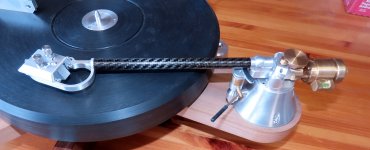
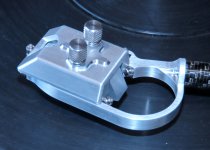
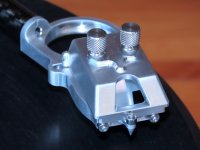
Last edited:
I picked up above a small excerpt of your post Andrey...............
It is not for me to teach you that in a linear tonearm (I do not take into account motorized designs) the needle is driven to the center by the outer side of the groove. As a result, the inner side is underloaded and some of the high-frequency information is lost.
................
Best regards,
AG.
I think it is fair to say that pivoted tone arms also move across the record driven by the stylus. So this is not a differentiation factor that makes one type better than the other. The load imposed may be, if the resistance is higher on one type or the other.
However the point i wanted to make is that the force necessary to move the cartridge, in either case, is never constant. Eccentricities will be present and the stylus is always following a path that wanders towards the centre of the record and back again. The path is a combination of the spiral and the variations. No records have a perfect spiral groove gradually easing in a constant way towards the centre. So the side load caused by that effect, which may affect the sound, varies constantly, and is not just on one side all the time. One side may or may not be dominant, averaged over the whole record width but that is unpredictable.
That leads me to believe that the tonearm needs to function satisfactorily to cope with that fact. i.e. they can move towards and away from the centre equally and easily.
I am looking forward to interesting discussions
Best
Mike
Hi Carlo.
I agree and disagree with what you said.
Thinking about this problem and the ways to solve it, I came to the conclusion that there is a compromise solution.
Of course, it is not the best solution. But it would reduce the impact of the sharp shift of pressureof the stylus from one side of the groove to the other side at eccentricity.
In this way, it would be possible to reduce the noticeability of the roll-off of high frequencies in one or the other channel.
This is a compromise solution. But it seems to me that it is less labor-intensive than carefully centering eachrecord.
Although this solution does not exclude careful centering.
AG.
I agree and disagree with what you said.
Thinking about this problem and the ways to solve it, I came to the conclusion that there is a compromise solution.
Of course, it is not the best solution. But it would reduce the impact of the sharp shift of pressureof the stylus from one side of the groove to the other side at eccentricity.
In this way, it would be possible to reduce the noticeability of the roll-off of high frequencies in one or the other channel.
This is a compromise solution. But it seems to me that it is less labor-intensive than carefully centering eachrecord.
Although this solution does not exclude careful centering.
AG.
Hi, Ralph.
I was looking at this amazing tonearm of yours with great interest.
I love people like you and Carlo, who have their own non-trivial view on non-trivial problems.
I will soon move on to the topic of Angling for 90° - tangential pivot tonearms".
AG.
I was looking at this amazing tonearm of yours with great interest.
I love people like you and Carlo, who have their own non-trivial view on non-trivial problems.
I will soon move on to the topic of Angling for 90° - tangential pivot tonearms".
AG.
Hello, Mike56.
I agree and disagree with your words.
I have my own concept for solving the rolling force problem.
And I am trying to put this concept into metal.
This is not a trivial task, but I have hope that I will solve it.
I have a problem communicating with you through an automatic translator.
I have to type the text in Russian, then run it through the translator, and then do a reverse translation,to make sure that the meaning is not distorted.
That is why I am not able to quickly respond to your posts.
Please take this into account and do not judge me harshly for the delay in response.
In addition, I have work to do around the house. And a hobby requires time.
Give me time.
Respectfully,
AG.
I agree and disagree with your words.
I have my own concept for solving the rolling force problem.
And I am trying to put this concept into metal.
This is not a trivial task, but I have hope that I will solve it.
I have a problem communicating with you through an automatic translator.
I have to type the text in Russian, then run it through the translator, and then do a reverse translation,to make sure that the meaning is not distorted.
That is why I am not able to quickly respond to your posts.
Please take this into account and do not judge me harshly for the delay in response.
In addition, I have work to do around the house. And a hobby requires time.
Give me time.
Respectfully,
AG.
- Home
- Source & Line
- Analogue Source
- DIY linear tonearm


